Behavior of Cross-Laminated Timber Panels Made from Fibre-Managed Eucalyptus nitens under Short-Term Serviceability Loads
Abstract
:1. Introduction
- To determine the maximum deflection of E. nitens CLT with different configurations under serviceability loads;
- To determine the fundamental natural frequency and damping ratio of E. nitens CLT with different configurations;
- To determine the maximum span of E. nitens CLT to comply with a criterion of first mode vibration frequency above 8 Hz with no furniture or floor coverings;
- To compare the serviceability performance of E. nitens CLT with Spruce CLT.
2. Materials and Methods
2.1. Timber Resource and Properties
2.2. CLT Configurations and Manufacturing
2.3. Description of Experimental Tests
2.3.1. Static Bending Tests
2.3.2. Vibration Tests
3. Results
3.1. Experimental and Theoretical Bending Stiffness
3.2. Mid-Span Deflections under Serviceability Loading
3.3. Dynamic Responses
4. Discussion
Further Research
5. Conclusions
Author Contributions
Funding
Data Availability Statement
Conflicts of Interest
References
- Pangh, H.; Hosseinabadi, H.Z.; Kotlarewski, N.; Moradpour, P.; Lee, M.; Nolan, G. Flexural performance of cross-laminated timber constructed from fibre-managed plantation eucalyptus. Constr. Build. Mater. 2019, 208, 535–542. [Google Scholar] [CrossRef]
- Ettelaei, A.; Taoum, A.; Nolan, G. Rolling shear properties of cross-laminated timber made of fibre-managed plantation eucalyptus under short-span bending. Wood Mater. Sci. Eng. 2021, 17, 744–751. [Google Scholar] [CrossRef]
- Ettelaei, A.; Taoum, A.; Shanks, J.; Nolan, G. Evaluation of the bending properties of novel cross-laminated timber with different configurations made of Australian plantation Eucalyptus nitens using experimental and theoretical methods. Structures 2022, 42, 80–90. [Google Scholar] [CrossRef]
- Ettelaei, A.; Taoum, A.; Shanks, J.; Nolan, G. Rolling Shear Properties of Cross-Laminated Timber Made from Australian Plantation Eucalyptus nitens under Planar Shear Test. Forests 2022, 13, 84. [Google Scholar] [CrossRef]
- Nero, R.; Christopher, P.; Ngo, T. Investigation of rolling shear properties of cross-laminated timber (CLT) and comparison of experimental approaches. Constr. Build. Mater. 2022, 316, 125897. [Google Scholar] [CrossRef]
- Derikvand, M.; Nolan, G.; Jiao, H.; Kotlarewski, N. What to do with structurally low-grade wood from Australia’s plantation eucalyptus; building application? BioResources 2017, 12, 4–7. [Google Scholar] [CrossRef] [Green Version]
- ABARES. Australian Plantation Statistics and Log Availability Report: October 2021; Australian Bureau of Agricultural and Resource Economics and Sciences: Canberra, Australia, 2021. [Google Scholar] [CrossRef]
- Derikvand, M.; Jiao, H.; Kotlarewski, N.; Lee, M.; Chan, A.; Nolan, G. Bending performance of nail-laminated timber constructed of fast-grown plantation eucalypt. Eur. J. Wood Wood Prod. 2019, 77, 421–437. [Google Scholar] [CrossRef]
- Derikvand, M.; Kotlarewski, N.; Lee, M.; Jiao, H.; Chan, A.; Nolan, G. Short-term and long-term bending properties of nail-laminated timber constructed of fast-grown plantation eucalypt. Constr. Build. Mater. 2019, 211, 952–964. [Google Scholar] [CrossRef]
- Blackburn, D.; Hamilton, M.; Harwood, C.; Innes, T.; Potts, B.; Williams, D. Stiffness and checking of Eucalyptus nitens sawn boards: Genetic variation and potential for genetic improvement. Tree Genet. Genomes 2010, 6, 757–765. [Google Scholar] [CrossRef]
- Derikvand, M.; Kotlarewski, N.; Lee, M.; Jiao, H.; Chan, A.; Nolan, G. Visual stress grading of fibre-managed plantation Eucalypt timber for structural building applications. Constr. Build. Mater. 2018, 167, 688–699. [Google Scholar] [CrossRef]
- Derikvand, M.; Kotlarewski, N.; Lee, M.; Jiao, H.; Nolan, G. Flexural and visual characteristics of fibre-managed plantation Eucalyptus globulus timber. Wood Mater. Sci. Eng. 2018, 15, 172–181. [Google Scholar] [CrossRef]
- McGavin, R.L.; Bailleres, H.; Hamilton, M.; Blackburn, D.; Vega, M.; Ozarska, B. Variation in rotary veneer recovery from Australian plantation Eucalyptus globulus and Eucalyptus nitens. BioResources 2015, 10, 313–329. [Google Scholar] [CrossRef] [Green Version]
- AS/NZS 1170.0; Structural Design Actions—General Principles. Standard Australia/Standard New Zealand: Sydney, Australia, 2002.
- EN 1995-1-1:2004; Eurocode 5: Design of Timber Structures—Part 1-1: General—Common Rules and Rules for Buildings. European Committee for Standardization (CEN): Brussels, Belgium, 2004.
- National Research Council (NRC). National Building Code of Canada; National Research Council (NRC): Ottawa, ON, Canada, 2005. [Google Scholar] [CrossRef]
- Karacabeyli, E. CLT Handbook: Cross-Laminated Timber, Canada Edition; FPInnovations: Pointe-Claire, QC, Canada, 2019; ISBN 978-086-488-592-0. [Google Scholar]
- Karacabeyli, E.; Douglas, B. CLT Handbook: Cross-Laminated Timber, US Edition; FPInnovations: Pointe-Claire, QC, Canada, 2013; ISBN 978-086-488-553-1. [Google Scholar]
- Gustafsson, A.; Crocetti, R.; Just, A.; Landel, P.; Olsson, J.; Pousette, A.; Silfverhielm, M.; Östman, B. The CLT Handbook: CLT Structures—Facts and Planning; Swedish Wood: Stockholm, Sweden, 2019; ISBN 978-919-832-144-3. [Google Scholar]
- Jeleč, M.; Rajčić, V. Cross-laminated timber (CLT)—A state of the art report. Građevinar 2018, 70, 75–95. [Google Scholar] [CrossRef] [Green Version]
- Pavic, A.; Reynolds, P. Vibration serviceability of long-span concrete building floors. Part 1: Review of background information. Shock. Vib. Dig. 2002, 34, 191–211. [Google Scholar]
- Ohlsson, S.V. Serviceability criteria–especially floor vibration criteria. In Proceedings of the 1991 International Timber Engineering Conference, London, UK, 2–5 September 1991; pp. 1.58–1.65. [Google Scholar]
- Hassan, O.A.; Girhammar, U.A. Assessment of footfall-induced vibrations in timber and lightweight composite floors. Int. J. Struct. Stab. Dyn. 2013, 13, 1350015. [Google Scholar] [CrossRef]
- Taoum, A.; Jiao, H.; Holloway, D.; Shanks, J. Behaviour of locally post-tensioned nail laminated high mass floor panels under serviceability loads. Aust. J. Struct. Eng. 2019, 20, 115–123. [Google Scholar] [CrossRef]
- Murray, T.; Allen, D.; Ungar, E. Floor Vibrations due to Human Activity; American Institute of Steel Construction, Inc.: Reston, VA, USA, 1997. [Google Scholar]
- Labonnote, N.; Rønnquist, A.; Malo, K.A. Prediction of material damping in timber floors, and subsequent evaluation of structural damping. Mater. Struct. 2015, 48, 1965–1975. [Google Scholar] [CrossRef]
- Bernard, E.S. Dynamic serviceability in lightweight engineered timber floors. J. Struct. Eng. 2008, 134, 258–268. [Google Scholar] [CrossRef]
- Jarnerö, K.; Brandt, A.; Olsson, A. Vibration properties of a timber floor assessed in laboratory and during construction. Eng. Struct. 2015, 82, 44–54. [Google Scholar] [CrossRef]
- Huang, H.; Gao, Y.; Chang, W.-S. Human-induced vibration of cross-laminated timber (CLT) floor under different boundary conditions. Eng. Struct. 2020, 204, 110016. [Google Scholar] [CrossRef]
- Wang, C.; Chang, W.-S.; Yan, W.; Huang, H. Predicting the human-induced vibration of cross laminated timber floor under multi-person loadings. Structures 2021, 29, 65–78. [Google Scholar] [CrossRef]
- Weckendorf, J.; Zhang, B.; Kermani, A.; Reid, D. Assessment of vibrational performance of timber floors. In Proceedings of the World Conference on Timber Engineering (WCTE), Portland, OR, USA, 6–10 August 2006. [Google Scholar]
- Hu, L. Serviceability of next generation wood buildings: Laboratory study of vibration performance of cross-laminated-timber (CLT) floors. In Project 301006159: Report 2012/13; FPInnovations: Sainte Foy, QC, Canada, 2013. [Google Scholar]
- Crovella, P.; Shahhosseini, S. Predicting the Strength and Serviceability Performance of Cross-laminated Timber (CLT) Panels Fabricated with High-Density Hardwood. In Proceedings of the World Conference on Timber Engineering (WCTE), Santiago, Chile, 9–12 August 2021. [Google Scholar]
- EN 338:2016; Structural Timber—Strength Classes. European Committee for Standardization (CEN): Brussels, Belgium, 2016.
- AS1080.1; Timber—Methods of Test Moisture Content. Standard Australia: Sydney, Australia, 2012.
- AS 1080.3; Timber—Methods of Test Density. Standard Australia: Sydney, Australia, 2000.
- AS/NZS 4063.1; Characterisation of structural timber Test methods. Standard Australia/Standard New Zealand: Sydney, Australia, 2010.
- Samson, M. Potential of finger-joined lumber for machine stress-rated lumber grades. For. Prod. J. 1985, 35, 20–24. [Google Scholar]
- Kutscha, N.; Caster, R.W. Factors affecting the bond quality of hem-fir finger-joints. For. Prod. J. 1987, 37, 43–48. [Google Scholar]
- Fisette, P.; Rice, W. An analysis of structural finger-joints made from two northeastern species. For. Prod. J. USA 1988, 38, 40–44. [Google Scholar]
- Bender, D.; Burk, A.; Taylor, S.; Hooper, J. Predicting localized MOE and tensile strength in solid and finger-jointed laminating lumber using longitudinal stress waves. For. Prod. J. 1990, 40, 45–47. [Google Scholar]
- EN 408:2010; Timber Structures—Structural Timber and Glued Laminated Timber—Determination of Some Physical and Mechanical Properties. European Committee for Standardization (CEN): Brussels, Belgium, 2010.
- Kreuzinger, H. Platten, Scheiben und Schalen–ein Berechnungsmodell für gängige statikprogramme. Bau. Mit Holz 1999, 1, 34–39. [Google Scholar]
- Crovella, P.; Smith, W.; Bartczak, J. Experimental verification of shear analogy approach to predict bending stiffness for softwood and hardwood cross-laminated timber panels. Constr. Build. Mater. 2019, 229, 116895. [Google Scholar] [CrossRef]
- AS/NZS 1170.1; Structural Design Actions—Part 1: Permanent, Imposed and Other Actions. Standard Australia/Standard New Zealand: Sydney, Australia, 2002.
- CSA O86:19; Engineering Design in Wood. National Standard of Canada: Ottawa, ON, Canada, 2021.
- Hamilton, J. Use of low grade timber in residential flooring systems. Bachelor’s Thesis, University of Tasmania, Hobart, Australia, 2014. [Google Scholar]
- Thomson, W.T. Theory of vibration with applications, 5th ed.; William, T., Thomson, M.D.D., Eds.; Prentice Hall: Hoboken, NJ, USA, 1998. [Google Scholar]
- Ohlsson, S.V. Floor Vibrations and Human Discomfort; Chalmers University of Technology, Division of Steel and Timber Structures: Göteborg, Sweden, 1982. [Google Scholar]
- Dolan, J.; Murray, T.; Johnson, J.; Runte, D.; Shue, B. Preventing annoying wood floor vibrations. J. Struct. Eng. 1999, 125, 19–24. [Google Scholar] [CrossRef]
- García, D.A.; Sampaio, R.; Rosales, M.B. Vibrational problems of timber beams with knots considering uncertainties. J. Braz. Soc. Mech. Sci. Eng. 2016, 38, 2661–2673. [Google Scholar] [CrossRef]
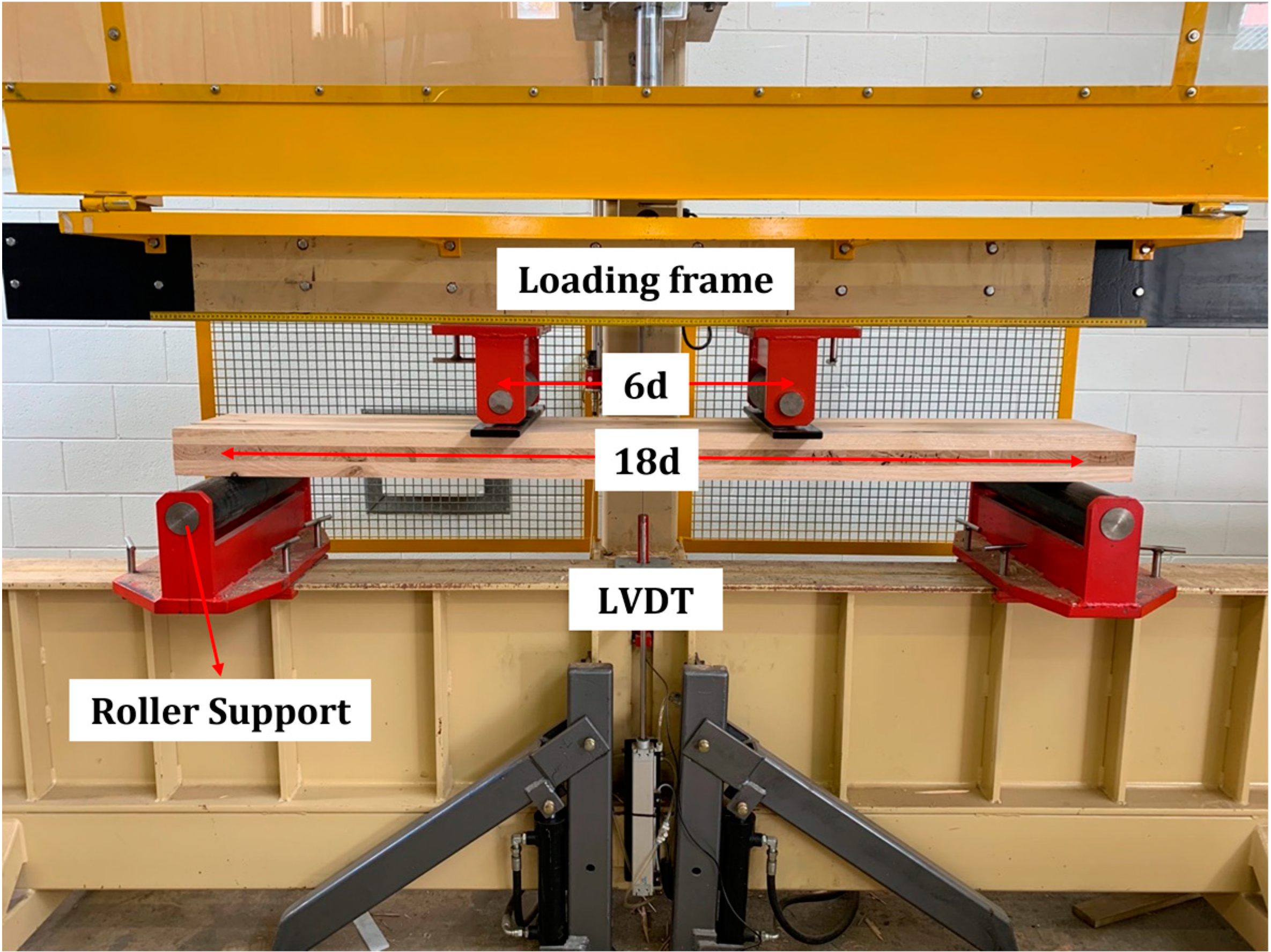

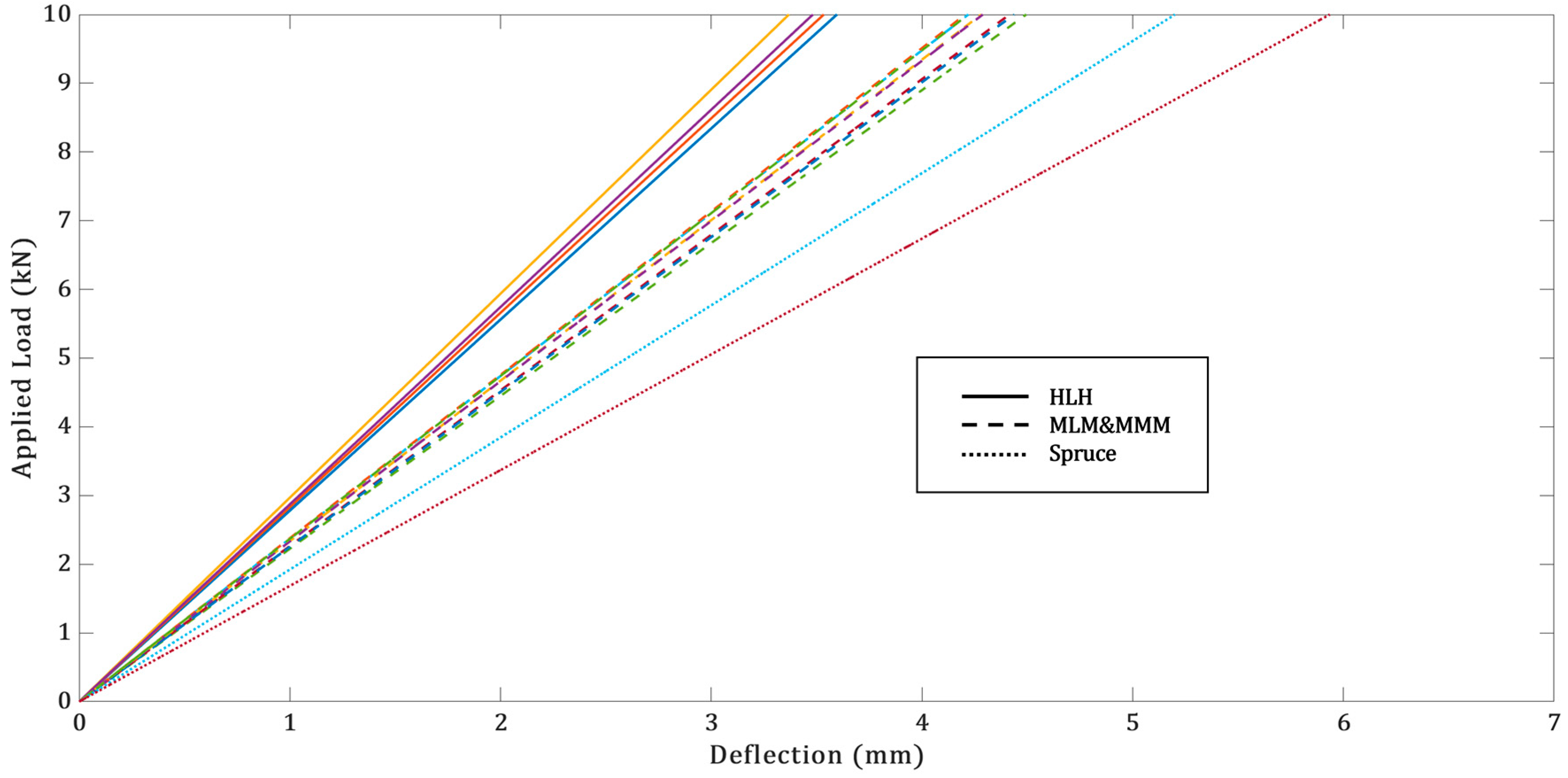
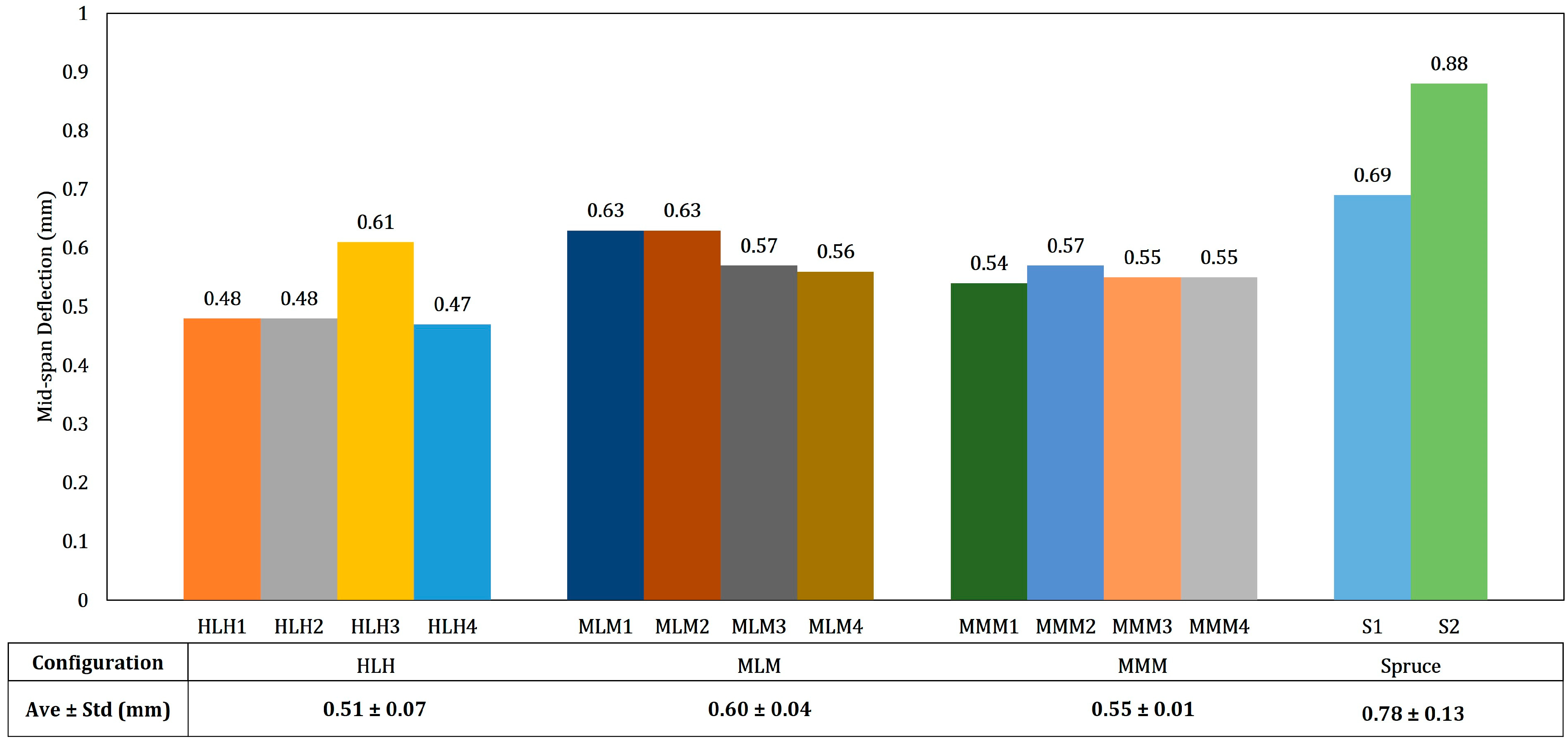
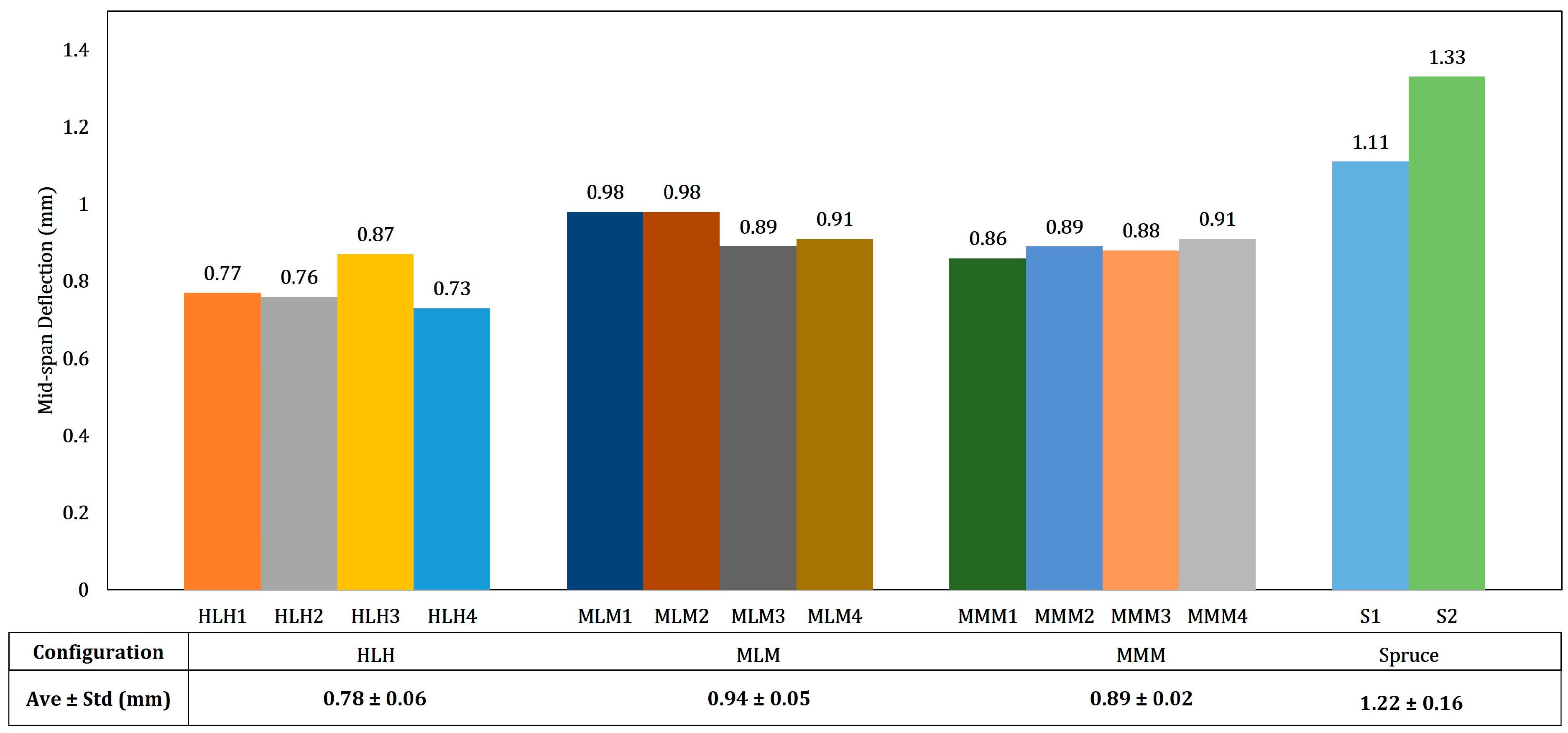
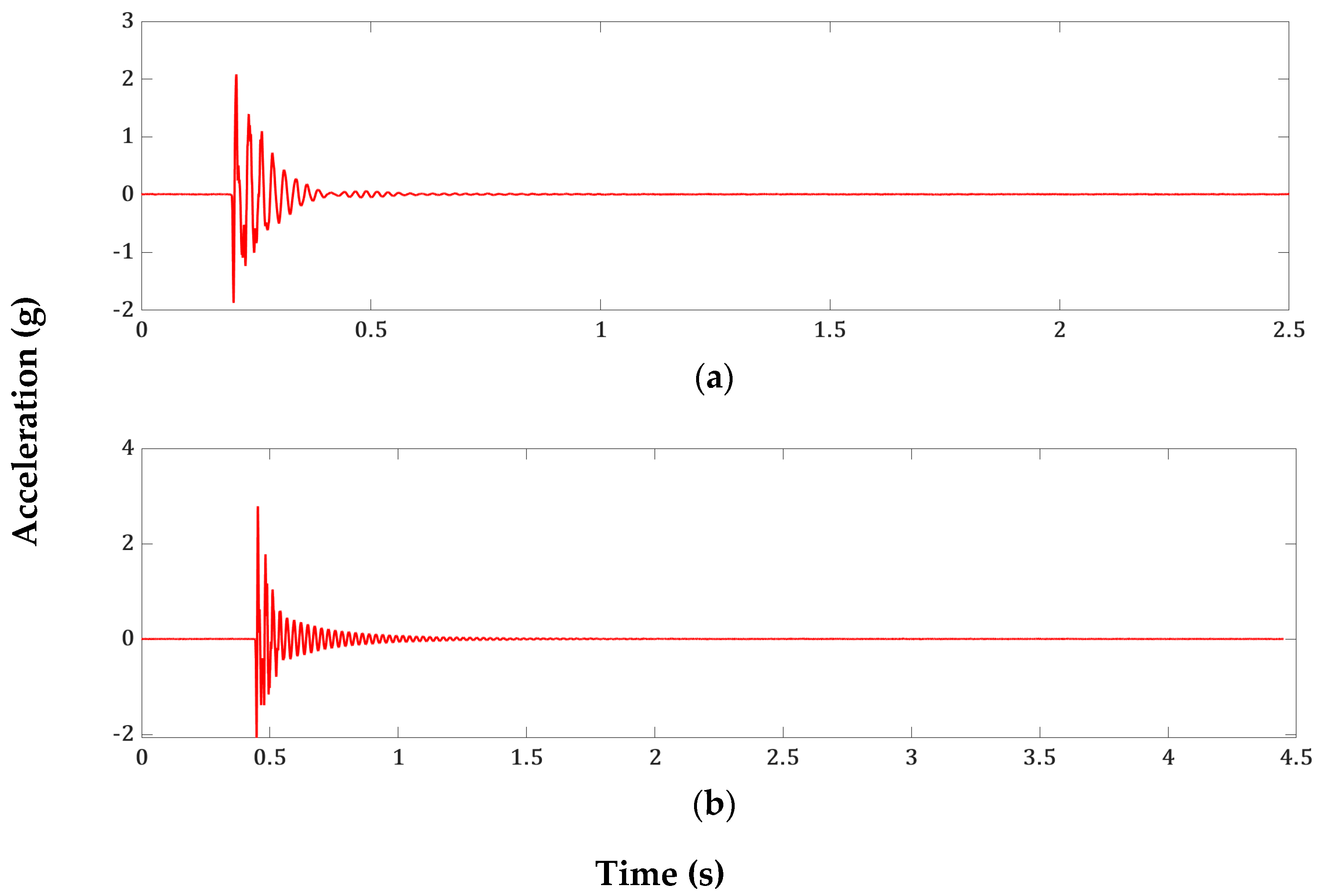
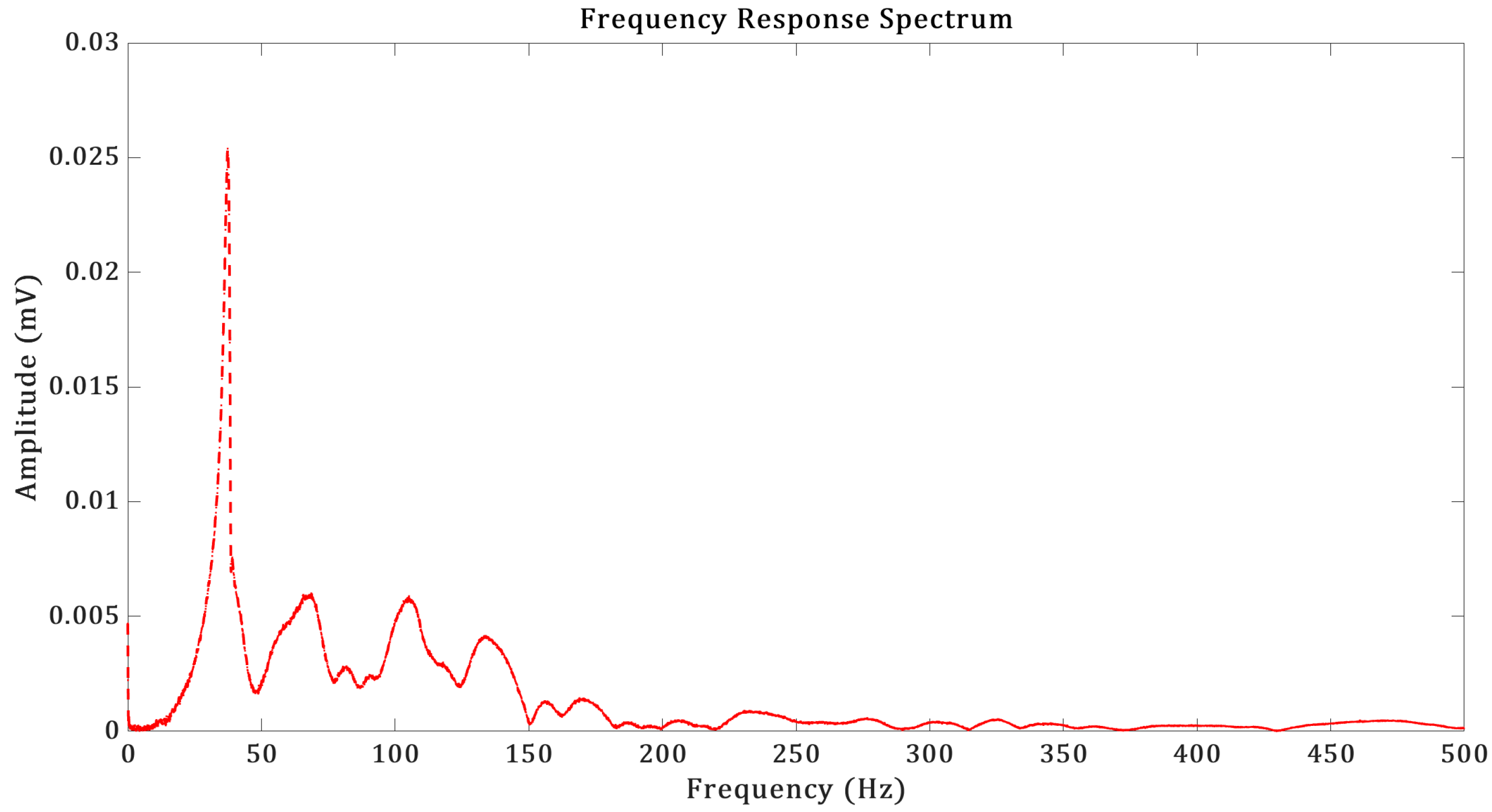
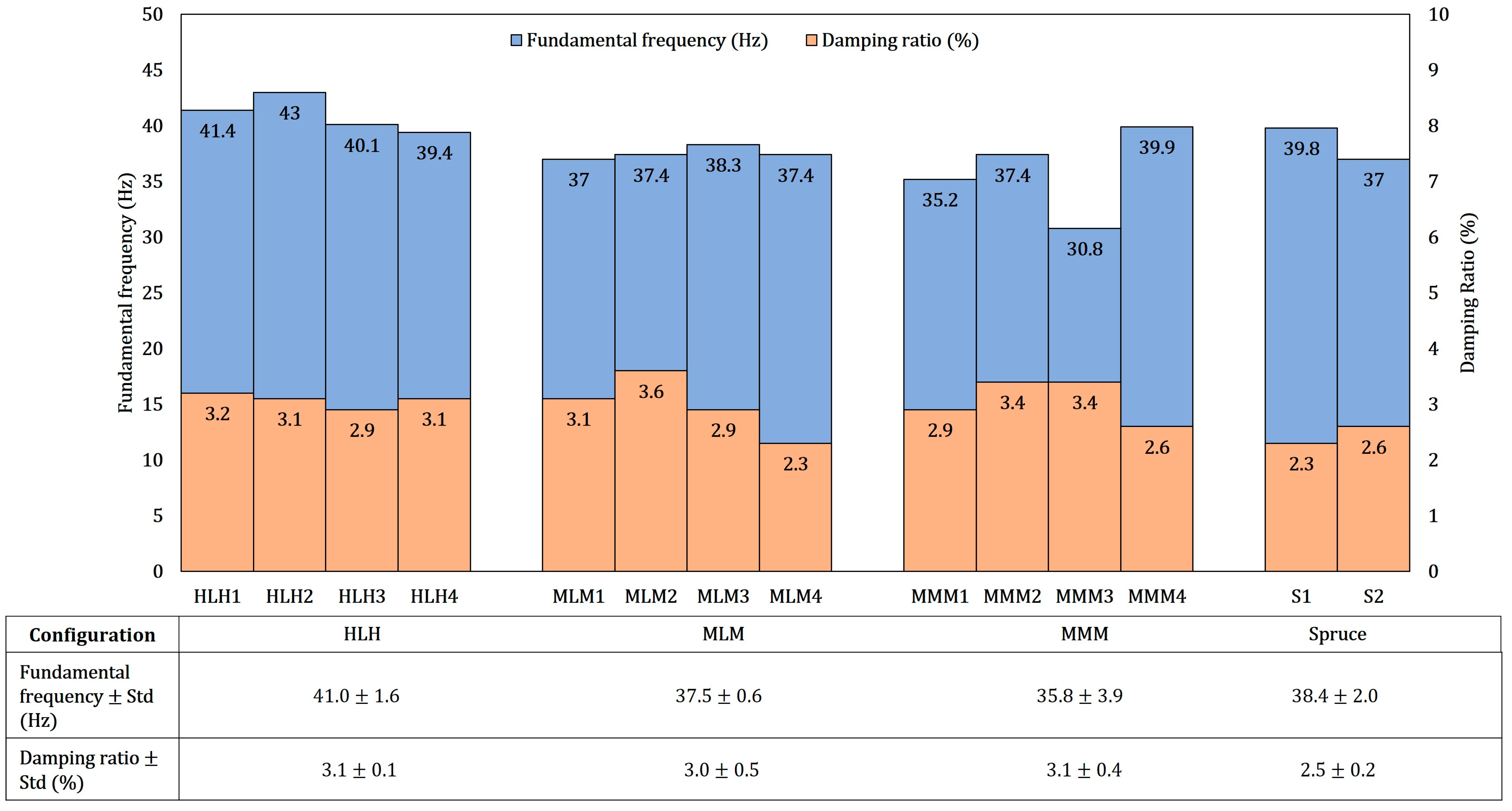
| Eucalyptus nitens Boards | |
|---|---|
| ± StdDev (kg/m3) | 517.5 ± 45.2 |
| ± StdDev (kg/m3) | 524.0 ± 45.7 |
| Mean moisture content, MC ± StdDev (%) | 9.7% ± 0.4 |
| Group | Name | MOE (GPa) ± StdDev |
|---|---|---|
| 1 | High | 13.1 ± 0.81 |
| 2 | Medium | 10.6 ± 0.67 |
| 3 | Low | 8.3 ± 0.17 |
| Species | Panel Code | Lamination Grade from Top to Bottom | Average MOEs of Individual Layers (GPa) |
|---|---|---|---|
| E. nitens | HLH1 | High Low High | 13.2 8.4 13.2 |
| HLH2 | |||
| HLH3 | |||
| HLH4 | |||
| MLM1 | Medium Low Medium | 10.6 8.4 10.6 | |
| MLM2 | |||
| MLM3 | |||
| MLM4 | |||
| MMM1 | Medium Medium Medium | 10.6 10.6 10.6 | |
| MMM2 | |||
| MMM3 | |||
| MMM4 | |||
| Spruce | S1 | Strength Class C24 1 | |
| S2 | |||
| Species | Configuration | Apparent MOE (GPa) | (N·mm2 × 1011) | (N·mm2 × 1011) | (N·mm2 × 1011) | (N × 106) | (N·mm2 × 1011) |
|---|---|---|---|---|---|---|---|
| Equations | (1) | MOE × I | (2) | (3) | (5) | (4) | |
| E. nitens | HLH1 | 11.3 | 2.90 | 2.93 | 3.06 | 1.95 | 1.88 |
| HLH2 | 10.9 | 2.81 | 2.83 | 3.11 | 1.95 | 1.90 | |
| HLH3 | 11.7 | 3.00 | 3.03 | 3.07 | 1.95 | 1.88 | |
| HLH4 | 11.5 | 2.96 | 2.99 | 3.10 | 1.95 | 1.90 | |
| MLM1 | 9.0 | 2.33 | 2.32 | 2.48 | 1.92 | 1.63 | |
| MLM2 | 9.7 | 2.50 | 2.50 | 2.47 | 1.92 | 1.63 | |
| MLM3 | 9.1 | 2.33 | 2.33 | 2.48 | 1.92 | 1.63 | |
| MLM4 | 9.0 | 2.31 | 2.31 | 2.49 | 1.92 | 1.64 | |
| MMM1 | 9.7 | 2.49 | 2.49 | 2.49 | 2.39 | 1.76 | |
| MMM2 | 9.4 | 2.42 | 2.42 | 2.48 | 2.39 | 1.75 | |
| MMM3 | 9.3 | 2.39 | 2.39 | 2.47 | 2.39 | 1.75 | |
| MMM4 | 9.5 | 2.46 | 2.45 | 2.49 | 2.39 | 1.75 | |
| Spruce | S1 | 8.3 | 2.01 | 1.96 | 2.57 | 2.48 | 1.82 |
| S2 | 7.5 | 1.81 | 1.78 | ||||
| Configuration | 1.25 kN Serviceability Load | 1.83 kN Serviceability Load | ||||
|---|---|---|---|---|---|---|
| Experimental Results | Theoretical Results | VAR (%) | Experimental Results | Theoretical Results | VAR (%) | |
| HLH | 0.51 | 0.52 | 1.96 | 0.78 | 0.79 | 1.28 |
| MLM | 0.60 | 0.61 | 1.67 | 0.94 | 0.92 | −2.13 |
| MMM | 0.55 | 0.58 | 5.45 | 0.89 | 0.87 | −2.25 |
| Spruce | 0.78 | 0.55 | −29.5 | 1.22 | 0.84 | −31.15 |
| Species | Configuration | (N·mm2 × 1011) | μ (kg/m) | λ1 |
|---|---|---|---|---|
| E. nitens | HLH | 1.89 | 12.6 | 0.79 |
| MLM | 1.63 | 11.8 | 0.76 | |
| MMM | 1.75 | 12.0 | 0.70 | |
| Spruce | S | 1.82 | 10.2 | 0.68 |
| Species | Configuration | Experimental Results (Hz) | Theoretical Results (Hz) | Variations (%) |
|---|---|---|---|---|
| E. nitens | HLH | 41.0 | 40.8 | −0.5 |
| MLM | 37.5 | 37.8 | −0.8 | |
| MMM | 35.8 | 35.7 | −0.3 | |
| Spruce | S | 38.4 | 38.4 | - |
| Species | Configuration | Maximum Span (m) | Addition Length Compared to Spruce CLT (%) |
|---|---|---|---|
| E. nitens | HLH | 4.4 | 4.8 |
| MLM | 4.2 | 0.0 | |
| MMM | 4.1 | −0.2 | |
| Spruce | S | 4.2 | - |
Disclaimer/Publisher’s Note: The statements, opinions and data contained in all publications are solely those of the individual author(s) and contributor(s) and not of MDPI and/or the editor(s). MDPI and/or the editor(s) disclaim responsibility for any injury to people or property resulting from any ideas, methods, instructions or products referred to in the content. |
© 2023 by the authors. Licensee MDPI, Basel, Switzerland. This article is an open access article distributed under the terms and conditions of the Creative Commons Attribution (CC BY) license (https://creativecommons.org/licenses/by/4.0/).
Share and Cite
Liang, Y.; Taoum, A.; Kotlarewski, N.; Chan, A.; Holloway, D. Behavior of Cross-Laminated Timber Panels Made from Fibre-Managed Eucalyptus nitens under Short-Term Serviceability Loads. Buildings 2023, 13, 245. https://doi.org/10.3390/buildings13010245
Liang Y, Taoum A, Kotlarewski N, Chan A, Holloway D. Behavior of Cross-Laminated Timber Panels Made from Fibre-Managed Eucalyptus nitens under Short-Term Serviceability Loads. Buildings. 2023; 13(1):245. https://doi.org/10.3390/buildings13010245
Chicago/Turabian StyleLiang, Yingwei, Assaad Taoum, Nathan Kotlarewski, Andrew Chan, and Damien Holloway. 2023. "Behavior of Cross-Laminated Timber Panels Made from Fibre-Managed Eucalyptus nitens under Short-Term Serviceability Loads" Buildings 13, no. 1: 245. https://doi.org/10.3390/buildings13010245






